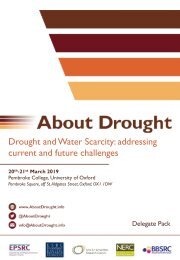About Drought Handbook: Outputs & Impacts
As the UK’s £12m Drought and Water Scarcity (DWS) research programme reaches its conclusion with a final event at The Royal Society in London, this handbook draws together the key outputs and outcomes. The book also features a series of interviews with our leading stakeholders, which highlight how successfully we have met our objectives to produce cutting-edge science that has made a demonstrable impact on how decision-makers manage water scarcity in the UK.
As the UK’s £12m Drought and Water Scarcity (DWS) research programme reaches its conclusion with a final event at The Royal Society in London, this handbook draws together the key outputs and outcomes. The book also features a series of interviews with our leading stakeholders, which highlight how successfully we have met our objectives to produce cutting-edge science that has made a demonstrable impact on how decision-makers manage water scarcity in the UK.
- No tags were found...
You also want an ePaper? Increase the reach of your titles
YUMPU automatically turns print PDFs into web optimized ePapers that Google loves.
drought impacts on freshwater ecosystems using an<br />
environmental monitoring dataset collated by the<br />
Environment Agency from the early 1990s. As the impact<br />
datasets are limited in time and space, we have developed<br />
statistical models to allow us to reconstruct the impacts<br />
of past drought episodes on river ecosystems more<br />
fully. This has demonstrated how the resilience of river<br />
ecosystems to drought varies around the country, and<br />
in particular how more heavily modified rivers are more<br />
vulnerable to drought impacts.<br />
From a water supply perspective, we have delivered a<br />
dataset of reservoir development in the UK from the late<br />
19th century onwards, illustrating how reservoir storage<br />
capacity has changed in this time. This has allowed us<br />
to develop timelines of past water supply, which we<br />
can then compare with timelines of demand, assembled<br />
from proxies (e.g. population). These supply / demand<br />
balances tell us much about changing water availability,<br />
which has a bearing on how droughts unfold and how<br />
they are managed. We have also cross-referenced this<br />
with a database of water supply impacts and drought<br />
management measures (drought orders, permits etc.),<br />
which we constructed using various water company<br />
reports and other sources.<br />
From an agricultural perspective, we have developed<br />
an agricultural drought inventory of past drivers,<br />
impacts and responses to drought, gathered using the<br />
agricultural media (e.g. Farmers Weekly) back to 1976.<br />
We have used this to demonstrate improvements<br />
in agricultural resilience over time – how farmers<br />
in eastern England have moderated the impacts of<br />
droughts over this timeframe through improved planning<br />
and communication with regulatory bodies.<br />
From a legal / regulation perspective, a database was<br />
developed using Hansard, to characterise the legal /<br />
policy responses of drought since the early 1970s. We<br />
have used this to demonstrate the changing governance<br />
backcloth to drought and water resources management<br />
in the UK, and how this has had an influence on the<br />
management of drought episodes, via the regulatory<br />
tools available and their relative efficacy.<br />
From a social and cultural perspective, two contrasting<br />
approaches were taken. One approach has been through<br />
first-hand interviews with affected communities (see<br />
page 40), where we gathered over 100 Oral Histories<br />
from people who have lived through drought episodes<br />
from the 1960s onwards. These tell us something very<br />
different from the hydrometeorological / water supply<br />
focused analysis, something that has been missing<br />
from the picture - how drought is understood by<br />
communities, people’s (diverse) lived experiences in<br />
drought episodes and how impacts have been felt and<br />
responded to. This sometimes diverges markedly from<br />
the way that drought is communicated by official bodies,<br />
and the understanding of people’s behavioural responses<br />
to drought can be used to frame improved drought<br />
communications in future.<br />
20<br />
A second approach has been to capture how drought is<br />
represented in the media. This has been done through a<br />
‘Corpus Linguistics’ approach which, uses computerised<br />
methods to objectively extract information from<br />
published newspaper archives back to the early 1800s.<br />
Not only does this provide a comprehensive archive of<br />
drought coverage over nearly 200 years – it also allows<br />
us to examine how the discourse around drought has<br />
changed over time. In the 19th century, for example, the<br />
word ‘drought’ was rarely used in connection with the<br />
many episodes of water shortage that occurred, whereas<br />
in recent years, ‘hosepipe bans’ have been a staple of the<br />
(often somewhat combative) narrative.<br />
Bringing it all together – accessibility and<br />
applications<br />
The various sectoral datasets have been combined into<br />
the UK <strong>Drought</strong> Inventory. This is a virtual collection of<br />
data, as the datasets are stored for long-term curation in<br />
different archives (the EIDC on the one hand and the UK<br />
Data Service for the social / economic data). However,<br />
all of the sectoral datasets are listed in one place and<br />
available to download (https://historicdroughts.ceh.ac.uk/<br />
content/datasets). The hydrometeorological datasets can<br />
also be explored in the CEH <strong>Drought</strong> Portal and various<br />
web tools (p.44). For the social and economic datasets<br />
based on text entries, we have developed a UK <strong>Drought</strong><br />
Inventory Explorer (p.45) to allow users to search for<br />
data spatially, in time, or using keywords.<br />
Mathematics lessons in 1976. Credit: Diana Monahan




